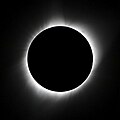| Total eclipse | |
| Gamma | 0.396 |
|---|---|
| Magnitude | 1.0578 |
| Maximum eclipse | |
| Duration | 271 s (4 min 31 s) |
| Coordinates | 46°36′N171°24′W / 46.6°N 171.4°W |
| Max. width of band | 207 km (129 mi) |
| Times (UTC) | |
| Greatest eclipse | 23:46:33 |
| References | |
| Saros | 124 (44 of 73) |
| Catalog # (SE5000) | 9101 |
A total solar eclipse occurred at the Moon's descending node of orbit between Saturday, June 26 and Sunday, June 27, 1824, with a magnitude of 1.0578. A solar eclipse occurs when the Moon passes between Earth and the Sun, thereby totally or partly obscuring the image of the Sun for a viewer on Earth. A total solar eclipse occurs when the Moon's apparent diameter is larger than the Sun's, blocking all direct sunlight, turning day into darkness. Totality occurs in a narrow path across Earth's surface, with the partial solar eclipse visible over a surrounding region thousands of kilometres wide. Occurring about 1.9 days before perigee (on June 28, 1824, at 20:40 UTC), the Moon's apparent diameter was larger. [1]
Contents
- Eclipse details
- Eclipse season
- Related eclipses
- Eclipses in 1824
- Metonic
- Tzolkinex
- Half-Saros
- Tritos
- Solar Saros 124
- Inex
- Triad
- Solar eclipses of 1823–1826
- Saros 124
- Metonic series
- Tritos series
- Inex series
- References
The path of totality was visible from parts of modern-day China, South Korea, North Korea, and Japan. A partial solar eclipse was also visible for parts of East Asia, Southeast Asia, Hawaii, and North America.






































































































